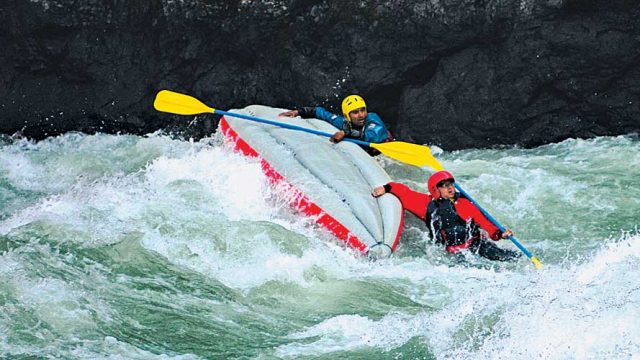Rishikesh, a small town nestled in the lower Himalayas, has always been synonymous with sanctitude, spirituality and yoga. Every year, this quaint town witnesses a footfall in millions. People from across the globe visit Rishikesh in order to seek spirituality. The mystique and intrigue is too strong a tempting force for many. But over the past two decades the town has become a crowd puller because of the plethora of adventure activities it offers. The topographical features along with the commercialization ensure one hell of a ride for all adventure enthusiasts out there.
Somehow for many tourists, their first taste of adventure is rafting, for reasons I find obvious. Firstly it is a team activity and is bound to attract families or youngsters travelling in groups and secondly because it is the most prominent thing here and is advertised well. Although it is an exhilarating experience, I was personally more enthused by its lesser known counterpart – white-water kayaking!


My Experience
Let me take you back to the moment when the germ of kayaking was first planted inside me. My first encounter with the white-waters was in a raft alongside a group of friends. All in all it was a great experience but not completely satisfying. The one thing that bothered me the most was the safety guy on the kayak. I couldn’t help myself from gazing at him. The way he manoeuvred his boat over the raging rapids and the ease with which he carved his way out was simply enviable. It felt like I was in a chauffeur driven touristy vehicle with a bunch of people; that guy, on the other hand, had his own ride and all the freedom in the world. The sense of achievement that may follow such acts eluded me and I was filled with an insatiable desire instead to be more than just a spectator. Rafting was good but just not enough.
When I visited Rishikesh the next time, I enrolled myself for a 4-day kayaking course with Team4adventure (India’s first kayak school; one day kayaking trip for ₹1,500–3,500). As an introduction to the extreme sport of white-water kayaking, they gave me some basic theoretical knowledge. Next, I was given a wet-suit, a helmet, a dry top, a spray deck and an imported kayak. I started on flat water with basic paddling. To my dismay, I was not able to steer the boat as per my will. It required paddling in a rhythmic way with constant motions which I failed to do at first. Rampant euphoria subsided into a kind of cheeriness but I never stopped trying. By the end of the day, I was able to steer and balance the kayak decently well. The next day we did a short river run on a Class II rapid. My encounter with the rapids on a kayak was very different from that on a raft. The same rapids that I had crossed on the raft earlier now appeared grander and loftier. During the course I received dedicated Eskimo roll lessons – a technique using which one could upright a flipped kayak without any help.

Kayaking is a technical sport. The muscles which are otherwise dormant in normal life are brought to use. So the river guides ensure that the Eskimo roll is taught gradually using the right techniques without straining the muscles. I got my roll on the fourth day. It gave me a sense of achievement which was missing after the rafting trip. Since that day, I’ve visited Rishikesh a few times to do longer river runs starting from the Marine Drive. The second time that I did it was with a German friend. He was a seasoned paddler who had paddled Class IV rapids.
Surprisingly, he had never seen a river like Ganga, he said. The volume, the high rapids and the peaceful yet lively shores left him awestruck. On seeing a professional paddler admire the grandeur of the Ganga, I finally felt proud of my achievement.
Where to Stay & Eat
The Glasshouse on the Ganges (Cell: 09412076420; Delhi Tel: 011- 46661666; Tariff: ₹8,500–15,000), in Gular-Dogi Village on the Badrinath Road, is the most luxurious. Aloha On The Ganges (Delhi Tel: 011-46520000; Tariff: ₹7,500–16,000) in Tapovan is one of the best stay options in Rishikesh. It offers amazing views of the River Ganga. Hotel The Great Ganga (Tel: 2442243, 2438252; Tariff: ₹4,000–9,800), is right above the Badrinath Road in Muni-ki-Reti and offers a panoramic view of the Ganga. The hotel has a multi-cuisine restaurant. GMVN has three large and well–maintained guest houses. Bharat Bhoomi Tourist Complex (Tel: 0135-2433002; Tariff: ₹990–2,500) is on the Dehradun Bypass Road, close to the bus stand and the railway station. Rishilok Tourist Complex (Tel: 2430373, Cell: 09568006684; Tariff: ₹330–2,090) at Muni-ki-Reti, across the road from the riverbank, has similar facilities. Ganga Resort Tourist Complex (Tel: 2438651; Tariff: ₹3,648–4,998), also in Muni-ki-Reti, has the best location, on the banks of the Ganga.
Almost all eateries in Rishikesh serve pure vegetarian food. The landmark Chotiwala Restaurant serves traditional food. Health freaks should visit Ajay Juice Centre near Ram Jhula. The German Bakery at Lakshman Jhula has interesting dishes such as yak cheese sandwiches and fruit pancakes.
Anna Café offers delicious food. Café Delmar offers Indian and Asian gluten-free vegetarian fare. Ramana’s Organic Café serves fresh organic salads and tasty desserts. Little Buddha serves Indian and Israeli fare. Honey Hut offers good coffee and cakes.
Getting There
Air Jolly Grant Airport, Dehradun, 22km/ 45min away. It is served by Air India. Taxis can be hired at ₹10–12 per km. Waiting charges are extra
Rail Convenient railhead is Haridwar, 25km/ 45min away, as its connected by the Shatabdi Express to Delhi and Dehradun. Taxis can be hired here or you can take a 1-hour bus ride to Rishikesh
Road Bus Night buses leave from Delhi’s Kashmere Gate ISBT for Haridwar, Rishikesh and Dehradun. Fares to Rishikesh range from ₹350–742; bookings can also be done through redbus.in




